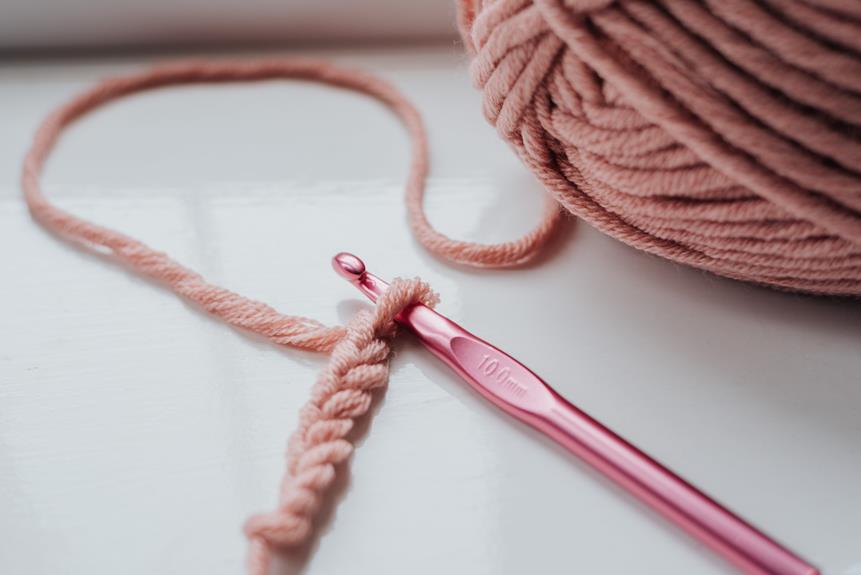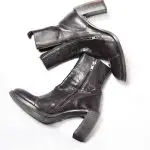Want to elevate your style while ensuring modesty? Discover the art of crafting your own cleavage cover with the DIY fabrics edition.
By combining your sewing skills with the perfect fabric selection, you can create a customized solution that enhances your outfits with grace and sophistication. This guide will walk you through the process, providing step-by-step instructions to achieve a flawless result.
Whether you're a seasoned seamstress or a novice crafter, mastering the creation of your cleavage cover will add a unique touch to your wardrobe.
Let's dive in and explore the world of DIY fashion with this essential accessory.
Key Takeaways
- Choose breathable fabrics like cotton, modal, or bamboo for comfort.
- Select fabrics that offer good coverage without feeling heavy or restrictive.
- Consider neutral colors like black, white, or nude for versatility.
- Take accurate body measurements using a flexible tape measure and a well-fitted bra.
Choosing the Right Fabric
Choose a fabric that provides sufficient coverage and comfort for your cleavage cover. When considering fabric types, opt for materials like cotton, modal, or bamboo for their breathability and softness against the skin. These fabrics are gentle and won't cause irritation, making them ideal choices for a cleavage cover. Additionally, these materials offer a good amount of coverage without feeling too heavy or restrictive.
Color choices are also important when selecting the fabric for your cleavage cover. Neutral colors such as black, white, or nude are versatile options that can seamlessly blend with different outfits. These colors also tend to be less visible under clothing, ensuring a discreet and polished look.
Ultimately, the fabric you choose for your cleavage cover should prioritize both coverage and comfort. Consider the environment in which you'll be wearing it and opt for a fabric that suits your needs. By selecting the right fabric and color, you can ensure that your cleavage cover not only serves its purpose but also complements your style and wardrobe effortlessly.
Taking Body Measurements
To ensure a proper fit, take your own body measurements before starting the cleavage cover DIY project. Proper fitting is essential for creating a comfortable and effective cleavage cover. When taking your measurements, use a flexible tape measure and wear a well-fitted bra to ensure accuracy.
| Measurement | Your Measurement (inches) | Ideal Measurement (inches) |
|---|---|---|
| Bust | 36 | 34 |
| Underbust | 32 | 30 |
| Across Back | 14 | 13 |
When measuring your bust, wrap the tape measure around the fullest part of your chest and ensure it's parallel to the ground. For the underbust, measure directly under your bust where the band of your bra would sit. The across back measurement should be taken from one armpit, around your back, to the other armpit. Once you have these measurements, you can select the appropriate fabric for your cleavage cover. Keep in mind the stretch and drape of the fabric to ensure it provides the desired coverage and comfort.
Cutting the Fabric Pieces
Take the fabric and lay it out on a flat surface.
Before cutting the fabric pieces for your cleavage cover, it's important to consider the fabric type. For a lightweight and breathable option, cotton or jersey knit fabrics are ideal choices. If you're looking for a more structured cover, consider using polyester blends or even a stretch denim fabric.
Once you've chosen the fabric type, it's time to consider the cutting techniques. Use sharp fabric scissors to ensure clean and precise cuts. If you're working with stretchy fabrics, make sure to gently stretch the fabric as you cut to prevent it from puckering or bunching up. For more stable fabrics, such as denim, ensure that you have a sharp pair of scissors that can handle the thickness.
Take your time with the cutting process to achieve accurate and smooth fabric pieces. Careful attention to the fabric type and cutting techniques will ensure that your cleavage cover turns out just the way you envisioned.
Sewing the Cleavage Cover
Once you have cut the fabric pieces for your cleavage cover, you'll begin sewing them together to create the final product. When sewing the cleavage cover, it's essential to utilize proper sewing techniques to ensure a professional and polished finish.
Start by aligning the fabric pieces with the right sides facing each other and pinning them in place to prevent shifting during sewing. Use a sewing machine or hand-stitching to carefully sew along the edges, leaving a small opening to turn the cover right side out. Trim any excess fabric and clip the corners to help the cover lay flat when turned.
After turning the cover right side out, use a tool such as a chopstick to gently push out the corners for crisp edges. Then, hand-sew the opening closed using a slipstitch for an invisible finish.
Custom sizing is crucial when sewing the cleavage cover to ensure a comfortable and secure fit. Take accurate measurements and make adjustments as needed to accommodate different body shapes and sizes.
Adding Decorative Details
Now that you have successfully sewn your cleavage cover, it's time to add some decorative details that will elevate its look.
Embellishing with fabric is a great way to add texture and visual interest to your cover.
You can also consider using lace and trims to add a touch of elegance and femininity to your creation.
Embellishing With Fabric
To add decorative details to your cleavage cover, start by carefully choosing and positioning your fabric. Once you have selected your fabric, it's time to embellish it with decorative details. Consider using embellishment techniques such as embroidery, appliqué, or beading to add a touch of elegance to your cleavage cover. When choosing embellishments, opt for lightweight materials to ensure comfort and flexibility. Here's a table to guide you through the process:
| Embellishment Technique | Description | Best Fabric Types |
|---|---|---|
| Embroidery | Intricate designs sewn onto the fabric | Cotton, satin, silk |
| Appliqué | Decorative fabric shapes sewn onto the base | Denim, wool, linen |
| Beading | Adding beads for a touch of sparkle | Chiffon, organza, tulle |
Carefully consider the fabric type and embellishment technique to achieve the desired look for your cleavage cover.
Using Lace and Trims
Select a delicate lace or trim that complements your fabric to enhance the aesthetic appeal of your cleavage cover. When choosing lace options, consider the color, width, and design that will best complement your fabric.
For a sleek and elegant look, opt for a narrow lace trim that adds a touch of femininity without overwhelming the design.
If you're aiming for a more dramatic effect, consider wider lace options with intricate patterns. Additionally, incorporating lace edging or decorative trims along the neckline or hem can elevate the overall look of your cleavage cover.
When adding lace or trims, ensure that they're securely attached and seamlessly integrated into the fabric.
These styling tips will help you create a cleavage cover that exudes sophistication and charm.
Testing the Fit
Before finalizing your cleavage cover, it's crucial to test the fit to ensure it provides the coverage and support you need.
Begin by adjusting the strap length to achieve the perfect fit and comfort.
Make sure the cover offers proper coverage while allowing flexibility for movement.
Adjusting Strap Length
How can you ensure the proper fit and comfort of your cleavage cover by adjusting the strap length?
Customizing the strap length is crucial in achieving the perfect fit for your cleavage cover. Here's how to adjust the strap length to ensure the best fit and comfort:
- Trial and Error: Experiment with different strap lengths to find the most comfortable and supportive fit for your cleavage cover.
- Consider Fabric Stretch: Depending on the fabric choice, you may need to adjust the strap length accordingly to accommodate for any stretch in the material.
- Design Options: Explore different design options for adjusting strap length, such as adjustable sliders or tie closures, to find the most suitable and customizable fit for your cleavage cover.
Ensuring Proper Coverage
Ensure proper coverage by testing the fit of your cleavage cover for comfort and support. A proper fit is crucial for both functionality and aesthetics.
When testing the fit, pay attention to the coverage level. The cleavage cover should provide adequate coverage without causing discomfort or constriction. Ensure that the fabric selection contributes to the desired fit. Different fabrics have varying levels of stretch and support, so choose a fabric that offers the right balance of flexibility and stability.
Additionally, assess the overall support provided by the cleavage cover. It should gently hug your skin without causing any bulging or indentation. Remember, a well-fitted cleavage cover not only enhances your comfort but also ensures a seamless and polished look.
Experiment with different fabric options to find the perfect fit for your needs.
Comfort and Flexibility
Once you have selected your fabric, carefully test the fit of your cleavage cover for comfort and flexibility. Ensure the cover allows for natural movement without causing any discomfort.
Here are some key points to consider:
- Flexible Design: Check that the cleavage cover moves with your body. It should adapt to different positions without feeling restrictive.
- Comfortable Materials: Prioritize fabrics that are soft and non-abrasive against your skin. The cover should feel comfortable to wear for extended periods.
- Breathability: Assess the breathability of the fabric. It's important that the material allows air to flow, preventing moisture buildup and enhancing overall comfort.
Final Touches and Styling
To achieve a polished look, consider adding embellishments such as lace or decorative trim to your cleavage cover. These final touches can elevate the appearance of your DIY cleavage cover and make it look more professional and stylish. When selecting embellishments, keep in mind the overall look you want to achieve and choose options that complement your personal style. Here are some styling tips and accessory options to consider:
| Accessory | Description | Styling Tip |
|---|---|---|
| Lace | Delicate and feminine | Layer lace along the edges for a dainty look |
| Beads | Adds a touch of glamour | Scatter beads for a subtle sparkling effect |
| Tassels | Bohemian and playful | Attach tassels for a fun and flirty vibe |
| Ribbon | Classic and versatile | Tie a ribbon bow for a charming touch |
These accessory options allow you to customize your cleavage cover to suit different occasions and outfits. Whether you prefer a romantic lace detail, a touch of glamour with beads, a playful vibe with tassels, or a classic look with ribbon, these final touches will add flair to your cleavage cover and enhance your overall ensemble.
Frequently Asked Questions
Can I Use Pre-Made Adhesive Cleavage Covers Instead of Making My Own?
You can opt for pre-made adhesive cleavage covers as a convenient buying option. They offer easy application techniques and can save time. Consider the various brands and find one that suits your needs and preferences.
How Do I Clean and Care for My DIY Cleavage Cover?
To maintain your DIY cleavage cover, gently hand wash it with mild soap and lukewarm water. Rinse thoroughly and air dry. Avoid using fabric softeners or harsh chemicals. Store it flat or hang it to prevent wrinkles.
Can I Use a Different Type of Closure Instead of the Suggested Hook and Eye Closure?
You can absolutely use different closure options for your DIY cleavage cover, such as snaps or Velcro. Additionally, alternative materials like ribbon or elastic can be used to create a customized closure that suits your preferences.
Are There Any Specific Fabrics I Should Avoid Using for This Project?
You should avoid using satin, silk, nylon, and polyester fabrics for cleavage covers. Opt for breathable, stretchy fabrics instead. These options will provide comfort and flexibility, ensuring your cleavage cover serves its purpose effectively.
Can I Add Padding or Inserts to My DIY Cleavage Cover for Extra Support?
Yes, you can add padding or fabric inserts to your DIY cleavage cover for extra support. Consider using alternative closures like hook-and-eye or adjustable straps for added security and comfort.
- Can You Get Organza Wet? - April 23, 2024
- Why Is Organza so Popular? - April 23, 2024
- What Do You Wear With Organza? - April 23, 2024






